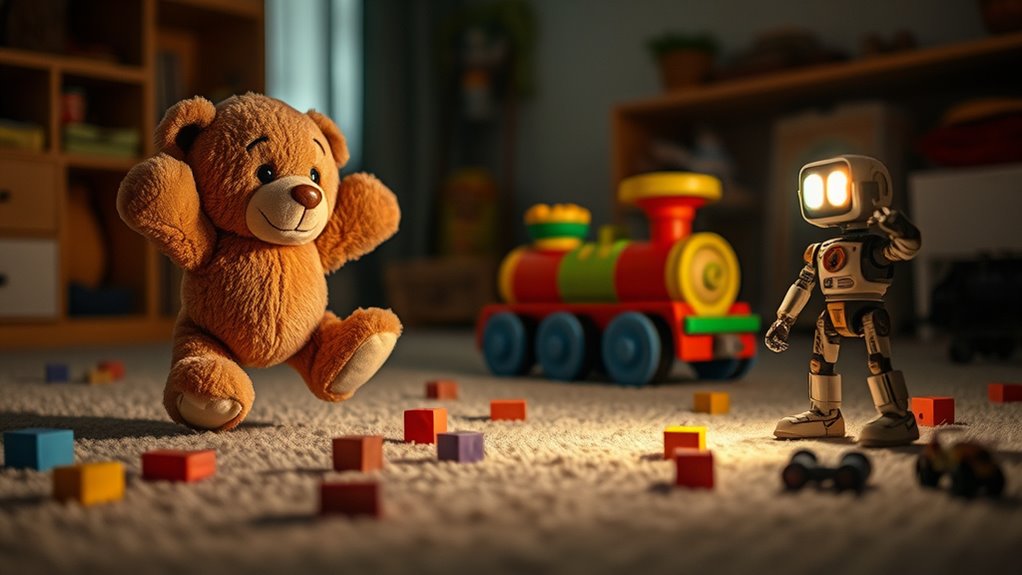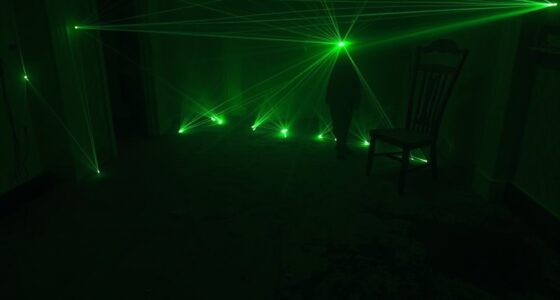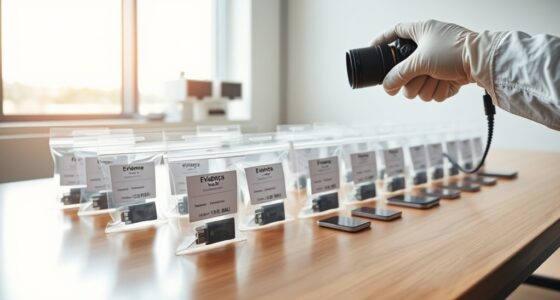Toys come alive when they use trigger objects and motion sensors to detect your touch or movement. These sensors, like infrared, ultrasound, or touch sensors, help toys respond instantly, creating engaging interactions. Proper calibration guarantees they react accurately without false triggers. Combining different sensors makes toys more lifelike and interactive. If you want to learn how to make your toys more responsive and safe, keep exploring these exciting technologies.
Key Takeaways
- Proper calibration of sensors ensures toys respond accurately to gestures, movement, or touch, preventing false triggers.
- Different sensors like infrared, ultrasound, and touch detect interactions and environmental changes to animate toys.
- Combining multiple sensors with programming creates more lifelike and reactive play experiences.
- Safety measures, including secure battery compartments and automatic shut-offs, are essential in sensor-based toys.
- Future innovations include AI, AR, and robotics to enhance interactivity, personalization, and sensory feedback in toys.
Understanding Trigger Objects and How They Work
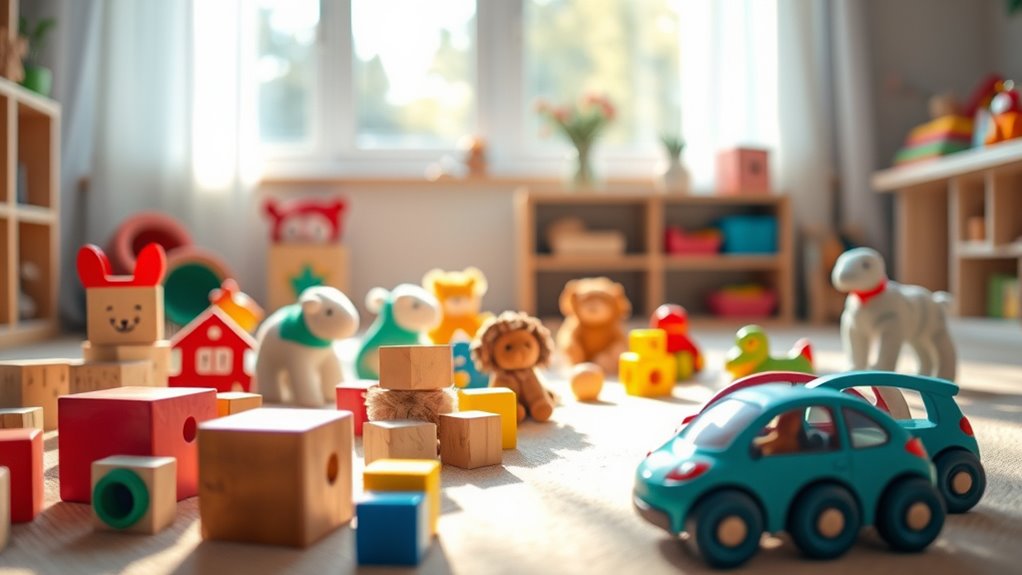
Have you ever wondered how some toys seem to spring to life on their own? It all comes down to trigger objects, which rely on precise sensor calibration and trigger timing. These toys use sensors that detect motion, sound, or touch, but they need to be finely tuned to respond accurately. Proper sensor calibration guarantees the toy recognizes the right signals without false triggers. Trigger timing is essential too; it determines when the toy reacts after sensing an input, making the interaction feel natural. If the timing is off, the toy might respond too early or too late, ruining the magic. Additionally, Mazda Tuning techniques can inspire how engineers fine-tune sensor responses in interactive toys. By mastering sensor calibration and trigger timing, manufacturers create toys that respond seamlessly, making them feel alive and truly interactive. Achieving optimal performance also involves understanding the sensor technology behind these devices, ensuring reliability and precision. The philosophical exploration of authenticity and existence can also shed light on how these toys are designed to create a sense of realism and engagement for users. Moreover, insights from Honda Tuning can provide innovative approaches to optimizing sensor and trigger performance in interactive systems.
The Role of Motion Sensors in Toy Interactivity
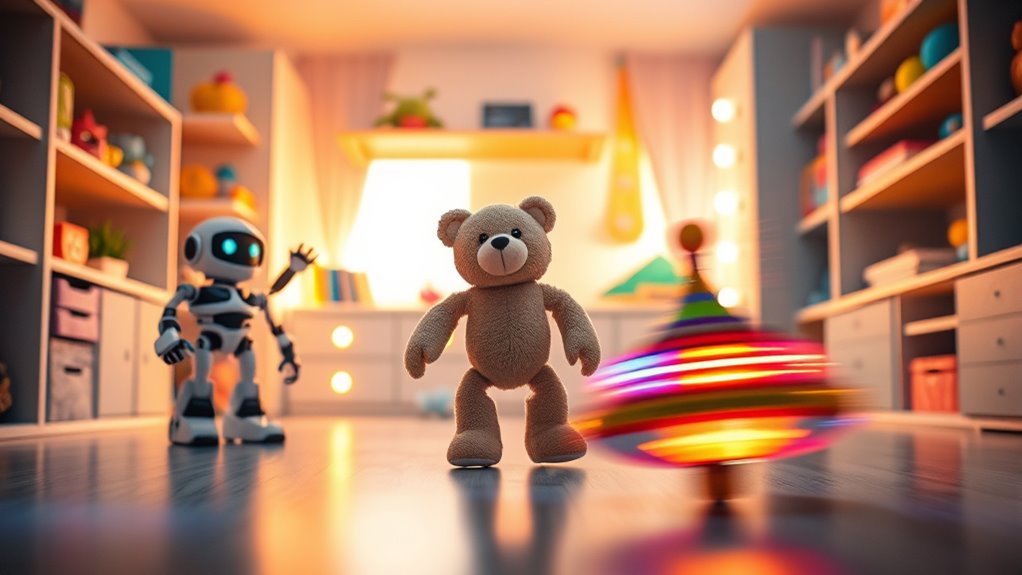
Motion sensors are the core technology that allows toys to detect movement and respond instantly. When you play with a toy equipped with a motion sensor, proper sensor calibration guarantees it accurately detects your gestures without false triggers. Calibration involves fine-tuning the sensor so it recognizes intended movements reliably. The user interface guides you through this process, making it simple to adjust sensitivity levels or reset the sensor if needed. Once calibrated, the toy reacts naturally to your motions, creating a seamless interactive experience. These sensors enable toys to respond to a wide range of movements, from gentle gestures to energetic actions. As a result, motion sensors transform static toys into lively, engaging companions that interact dynamically with you. Proper use of user privacy and cookies ensures that your interactions remain secure and compliant with privacy standards.
Types of Sensors Used in Modern Toys
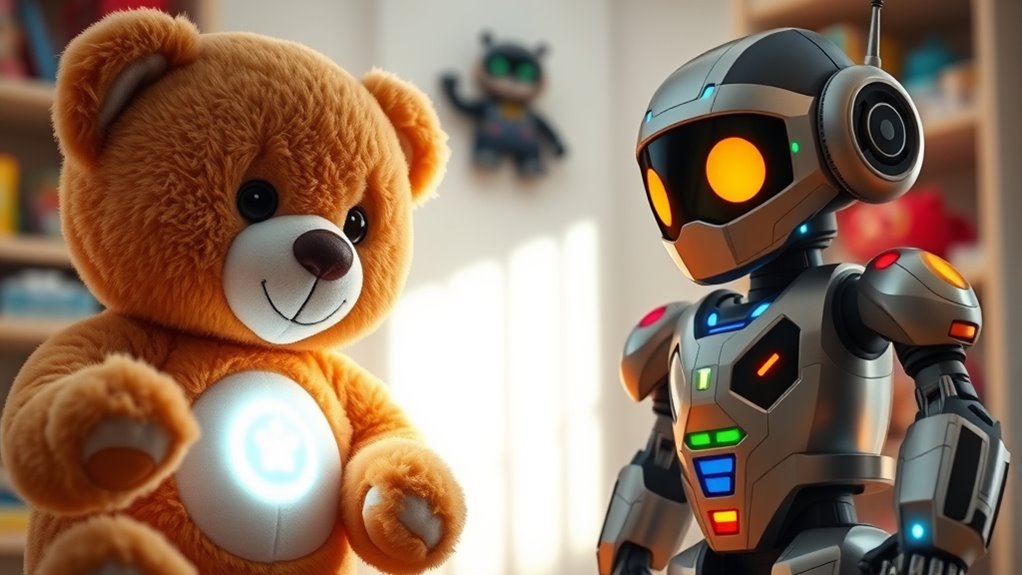
Modern toys use a variety of sensors to respond to your actions. Infrared and ultrasound sensors detect distance and motion, while touch sensors sense when you interact physically. Together, these sensors make toys more interactive and lifelike. Additionally, some toys incorporate advanced sensing technologies to enhance their responsiveness and realism. The integration of sensor-driven features allows for more engaging and intuitive play experiences. Incorporating smart technology in toys also encourages responsible and mindful play, promoting healthier interactions and fostering creative expression through customization options.
Infrared and Ultrasound
Infrared and ultrasound sensors play a crucial role in bringing toys to life by enabling them to detect movement and interact with their environment. These sensors use emitted signals to gauge distance and motion, making interactions more natural. Proper sensor calibration guarantees accurate response, while a user interface allows you to control and customize the toy’s reactions. Infrared sensors detect heat or reflected light, ideal for proximity detection. Ultrasound sensors emit sound waves, measuring echo return times for precise distance measurement. Here’s a quick overview:
| Sensor Type | How It Works | Uses in Toys |
|---|---|---|
| Infrared | Detects reflected infrared light | Proximity, gesture control |
| Ultrasound | Measures echo of sound waves | Obstacle avoidance |
| Calibration | Ensures accurate readings | Enhances user experience |
Additionally, understanding the sensor calibration process is vital for maintaining optimal toy performance, especially since local knowledge can influence how sensors are optimized for specific environments. Incorporating environmental factors into calibration procedures can further improve the accuracy and responsiveness of these sensors in various settings. A thorough understanding of sensor types helps in selecting the right technology for different toy applications.
Motion and Touch Sensors
Many toys now incorporate motion and touch sensors to create more interactive experiences. These sensors detect your movements or touch, bringing toys to life. To work accurately, sensors require proper calibration, ensuring they respond correctly to your actions. Environmental interference, like bright lights or nearby objects, can disrupt sensor performance, so designers minimize these factors. Proper sensor calibration is essential for maintaining responsiveness and avoiding false triggers.
This combination creates toys that feel more responsive and lifelike.
Creative Uses of Trigger Mechanisms in Playtime
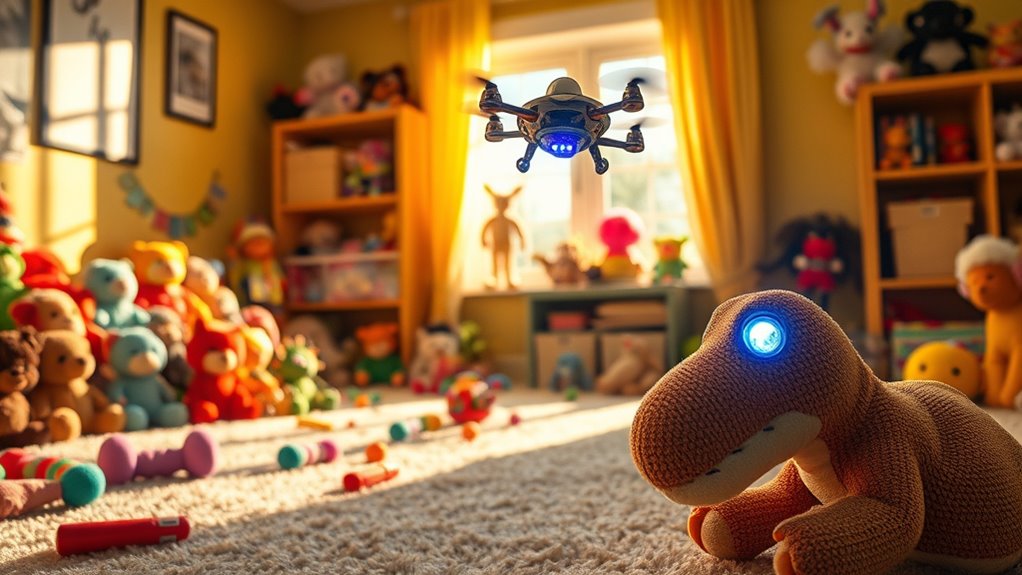
Trigger mechanisms transform simple toys into surprising play experiences by enabling actions that seem almost alive. Creative uses of these mechanisms include interactive storytelling, where sensor calibration guarantees accurate responses to a child’s touch or movement, making the toy feel intuitive and responsive. You can also design toys that react differently based on how they’re used, adding depth to play. To maintain long-lasting fun, toy durability is essential, especially when trigger components are frequently activated. Reinforcing sensor placements and using sturdy materials helps prevent malfunctions. Support hours for toy maintenance and troubleshooting are available through various channels, ensuring toys remain in top condition. These thoughtful applications make playtime more engaging, encouraging imagination and exploration. By focusing on precise calibration and durable construction, you create toys that delight children while standing up to active use. Additionally, selecting components that are resistant to wear and tear enhances overall toy longevity, ensuring sustained enjoyment over time.
Building Interactive Toys With Simple Electronics
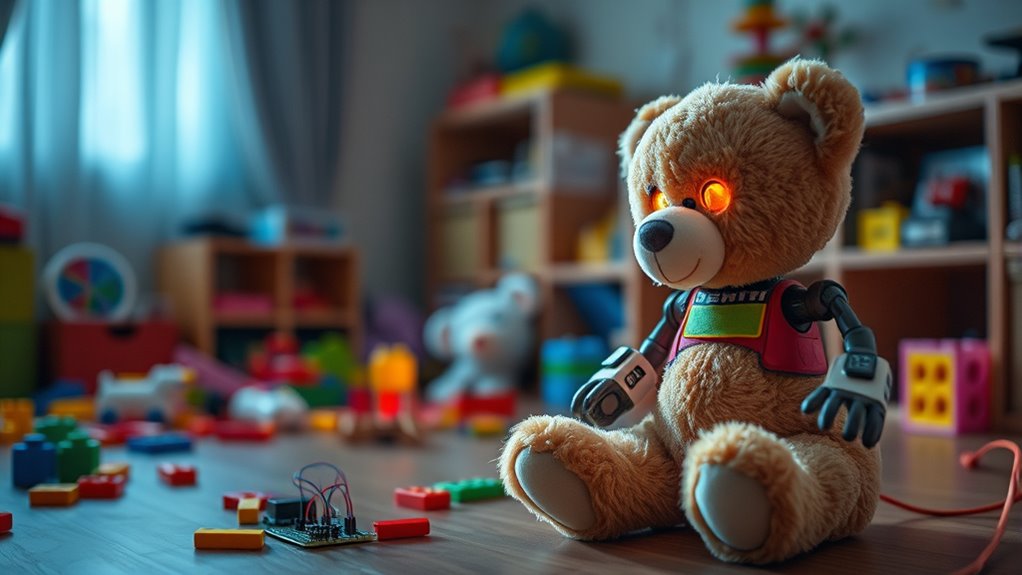
Building interactive toys with simple electronics is easier than you might think, even if you’re new to electronics. You can create engaging experiences by integrating basic components like sensors and microcontrollers. Here are four steps to get started:
- Choose a sensor—motion sensors or trigger objects—to detect interaction.
- Connect the sensor to a microcontroller, such as an Arduino or Raspberry Pi.
- Program the microcontroller to activate effects, like sounds or lights, when triggered.
- Incorporate virtual reality or augmented reality elements to enhance immersion.
This approach allows you to develop toys that respond to touch or movement, making playtime more dynamic. Simple electronics open the door to creating toys that blend physical and digital worlds seamlessly.
Safety Considerations for Sensor-Enabled Toys

While designing sensor-enabled toys can enhance play experiences, ensuring safety must be your top priority. Proper sensor calibration is essential to prevent false triggers or missed detections, which could cause frustration or safety issues. Regularly test and adjust sensors to ensure they respond accurately to intended stimuli. Battery safety is equally critical; use approved batteries and ensure they are securely enclosed to prevent leaks, overheating, or accidental ingestion. Incorporate safety features such as automatic shut-offs or low-battery alerts to minimize risks. Always adhere to safety standards and guidelines, and clearly label battery compartments to prevent tampering. By focusing on sensor calibration and battery safety, you create a safer, more reliable toy that offers fun without compromising well-being.
Innovations and Future Trends in Toy Technology
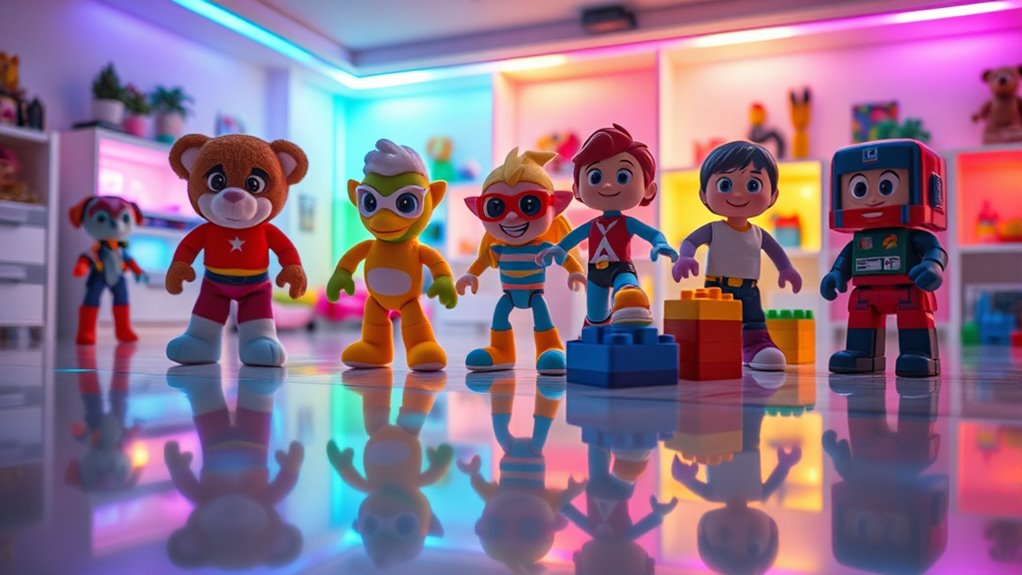
Advancements in toy technology are rapidly shaping the future of play, blending artificial intelligence, augmented reality, and robotics to create more immersive and personalized experiences. You’ll see innovations like haptic feedback, which adds tactile sensations to make interactions feel real, and sensory integration, enhancing how toys respond to touch and sound. Future trends include:
Toy technology is evolving with AI, AR, and robotics for immersive, personalized play experiences.
- Smarter toys that adapt to your child’s learning pace using AI.
- Augmented reality features that blend digital and physical play.
- Enhanced sensory feedback for more engaging interactions.
- Robotics that enable more lifelike movements and responses.
These developments will make toys more intuitive and responsive, deepening engagement and creating experiences that feel almost alive. You’ll notice a shift towards more sensory-rich, immersive play that captivates children and encourages creativity.
Popular Examples of Toys With Trigger and Motion Features
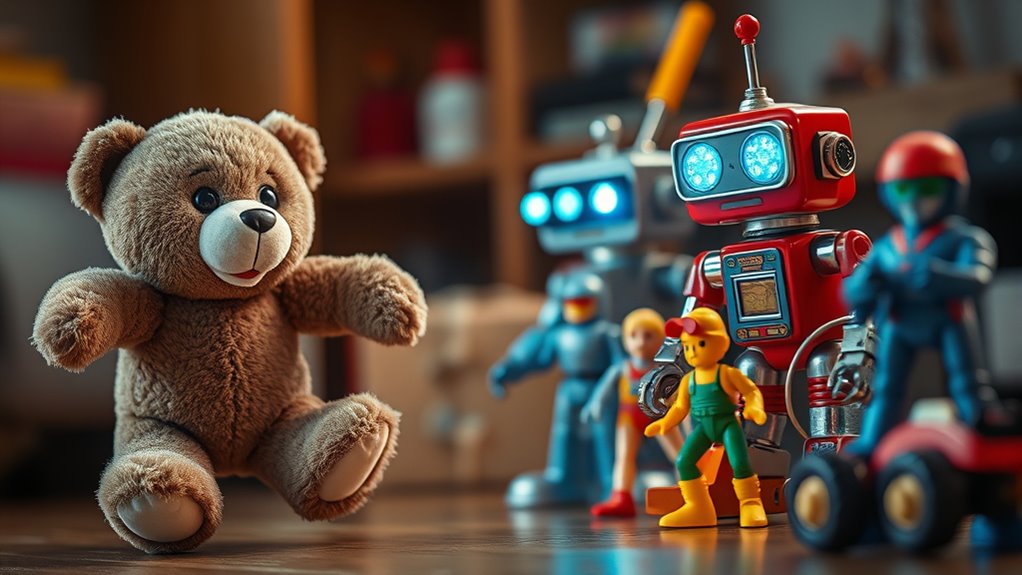
You’ve probably seen toys that respond to your actions or voice, making playtime more exciting. Interactive plush animals, voice-activated robots, and motion-detecting drones are great examples that bring toys to life. Let’s explore how these features make play more engaging and fun.
Interactive Plush Animals
Interactive plush animals have become some of the most beloved toys for children, thanks to their engaging trigger and motion features. These toys promote sensory development by responding to touch, sound, or movement, making playtime more immersive. They also foster emotional bonding, as children form connections with their lifelike companions.
Here are some popular examples:
- Plush animals that respond to hugs with sounds or movements.
- Toys that activate when touched in specific spots.
- Animals that mimic breathing or heartbeat for comfort.
- Interactive plush friends that react to voice commands.
These features create a dynamic play experience, encouraging children to explore their senses while building emotional connections with their plush companions.
Voice-Activated Robots
Voice-activated robots have become a favorite among children because they respond instantly to spoken commands and gestures, creating an engaging and realistic play experience. These toys use advanced robot voice modulation to produce natural-sounding responses, making interactions feel more lifelike. To guarantee they understand commands accurately, manufacturers employ sensor calibration techniques that fine-tune microphones and sensors for peak performance. Proper calibration minimizes false activations and improves responsiveness. You’ll notice these robots recognize a variety of voice tones and commands, encouraging kids to experiment and interact creatively. Their ability to adapt to different voices and environments relies heavily on precise calibration. Overall, these features make voice-activated robots an exciting, intuitive toy that enhances imaginative play through seamless, responsive interaction.
Motion-Detecting Drones
Motion-detecting drones have gained popularity because they respond instantly to movement, creating dynamic and engaging play experiences. These drones can chase you around, dodge obstacles, or even interact with robotic dolls, making play more immersive. Many models incorporate augmented reality features, blending real-world motion with digital enhancements. Here are some key aspects:
- They activate with your movement, encouraging active play.
- Some include robotic dolls that respond to drone movements.
- Augmented reality integration enhances interactive experiences.
- Their sensors detect motion patterns, making gameplay more unpredictable.
This combination of motion sensors and augmented reality elevates toy drones beyond simple flying devices, transforming them into interactive companions that respond to your every move.
Tips for Parents and Educators to Enhance Play Experiences
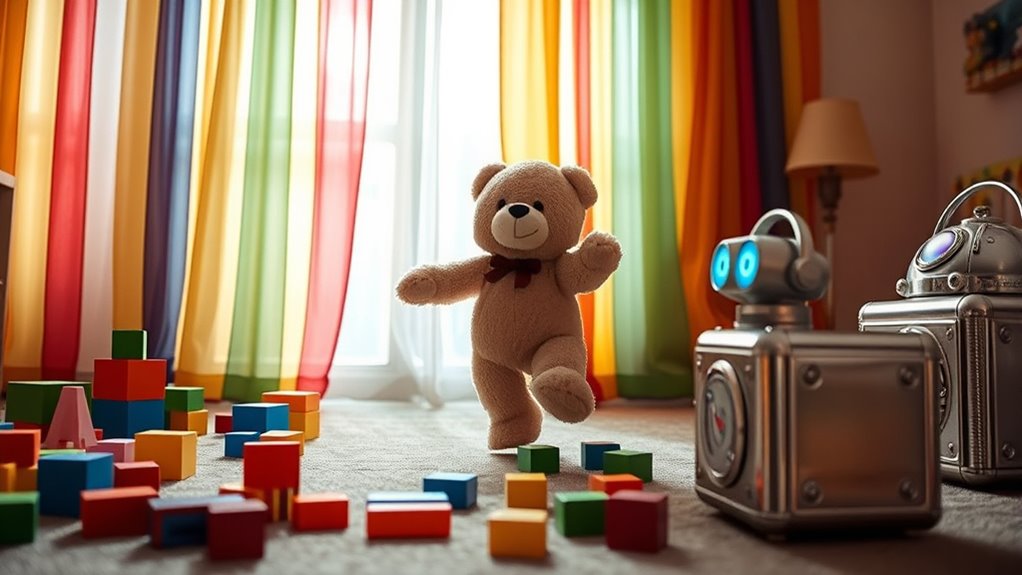
To make playtime more engaging and meaningful, parents and educators should focus on creating an environment that encourages imagination and exploration. Understanding historical perspectives helps you appreciate how toys have evolved, shaping children’s play across cultures. Incorporate cultural influences by including diverse toys that reflect different traditions, fostering inclusivity and creativity. Use trigger objects and motion sensors thoughtfully to inspire storytelling and problem-solving.
| Tip | Implementation |
|---|---|
| Respect historical contexts | Introduce vintage or traditional toys for depth |
| Celebrate cultural diversity | Incorporate toys representing various cultures |
| Encourage imaginative play | Use trigger objects to prompt storytelling |
| Foster exploration | Set up different themed zones for sensory engagement |
| Observe and adapt | Tailor activities based on children’s reactions |
Frequently Asked Questions
How Do Trigger Objects Affect a Child’s Sensory Development?
Trigger objects can markedly influence your child’s sensory development by promoting sensory integration. When they interact with these objects, your child engages multiple senses, helping them meet important developmental milestones. These objects encourage exploration and improve coordination, balance, and tactile awareness. By providing stimulating experiences, trigger objects support your child’s growth, making sensory processing smoother and more effective as they develop essential skills for everyday activities.
Are There Specific Age Recommendations for Toys With Motion Sensors?
You should always check age appropriateness and safety guidelines before giving a child toys with motion sensors. Typically, manufacturers recommend these toys for children aged three and up, due to small parts or complex features. Always supervise play to ensure safety, especially for younger kids. Following these guidelines helps prevent accidents and guarantees your child enjoys the toys safely while supporting their developmental needs.
Can Trigger Mechanisms Be Customized for Individual Play Preferences?
Imagine your toy as a blank canvas, ready for your personal touch. You can customize trigger mechanisms to match your unique play style, turning ordinary toys into personalized adventures. While some toys offer flexible personalization options, others present customization challenges like limited features or complicated setups. But with a little creativity and patience, you can craft a toy that responds exactly how you want, making playtime truly your own masterpiece.
What Are Common Maintenance Needs for Sensor-Enabled Toys?
You should regularly maintain sensor-enabled toys by checking battery levels and replacing batteries when they run low. Also, perform calibration procedures as needed to guarantee sensors respond accurately. Keep the sensors clean and free from dust or debris to prevent malfunctions. Following these steps helps your toys stay responsive and prolongs their lifespan, ensuring you enjoy their interactive features without unnecessary interruptions.
How Do Different Cultural Contexts Influence Toy Design With Sensors?
Different cultural contexts shape toy design with sensors by emphasizing cultural symbolism and values. You’ll notice design diversity, reflecting local traditions, stories, and social norms. For example, in some cultures, toys incorporate specific symbols or colors to convey meaning, while others prioritize functionality aligned with local lifestyles. This cultural influence guarantees that sensor-enabled toys resonate more deeply, fostering connection and relevance for children across diverse backgrounds.
Conclusion
As you explore the world of trigger objects and motion sensors, you’ll discover endless ways to make playtime more engaging and interactive. Embracing these innovations can turn ordinary toys into extraordinary experiences, much like the enchanted automaton of a Victorian parlor. By understanding safety and creative application, you’re shaping a future where technology enhances learning and fun. So, keep experimenting and inspiring curiosity—after all, the magic of discovery never truly goes out of style.
